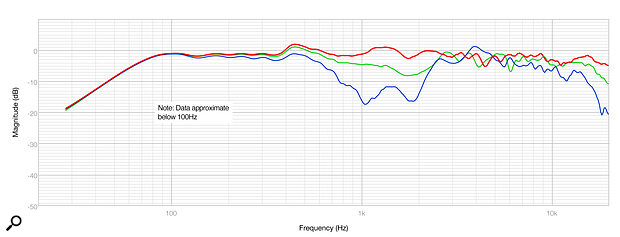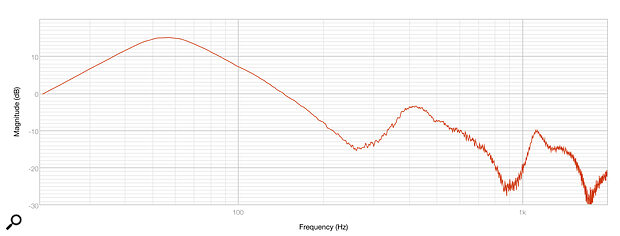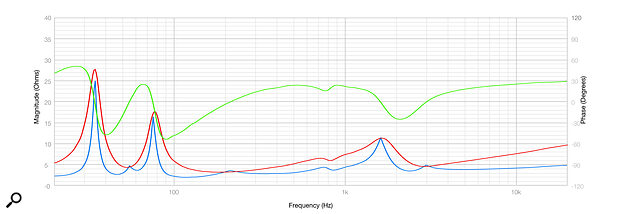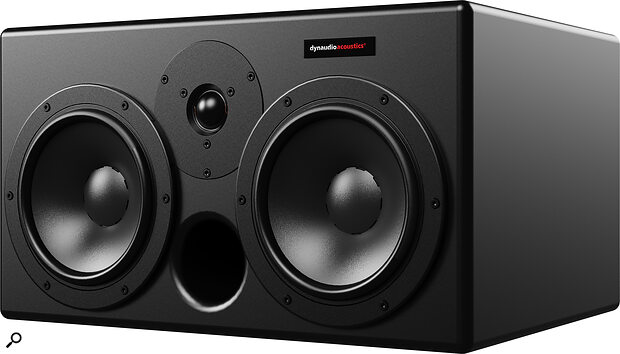In updating their classic M Series, Dynaudio Acoustics show that passive doesn’t need to mean low‑tech.
Dynaudio Acoustics, together with studio designer and acoustician Andy Munro, played a really significant role in the development of the contemporary professional studio monitor — particularly in Europe. The story goes that Andy Munro, dissatisfied with the horn‑loaded compression tweeters found in the vast majority of main studio monitors of the 1970s and 1980s, hunted around Europe’s specialist driver manufacturers to find one that could supply high‑performance, non‑compression tweeters able to survive the rigours of studio use. Munro alighted on Dynaudio in Denmark, and a deal was done that brought the company’s renowned drivers into a range of Munro‑designed and ‑manufactured studio monitors. The monitors would be marketed by Munro, but with Dynaudio Acoustics branding. That monitor range was the original Dynaudio Acoustics M Series, and over the last three and a half decades, M Series monitors have been installed in countless studios the world over.
All Change
The original M Series speakers ranged from relatively compact nearfield/midfield models right up to huge, soffit‑mounted systems incorporating multiple bass drivers, and although they were incrementally developed and improved over the decades, there was never a root and branch redesign — until now. Once again, Munro Acoustics have taken the best of Dynaudio’s driver technology and built around it a range of new M Series passive and hybrid active studio monitors. The new M Series again encompasses models from the relatively compact M1 MkII right up to the enormous, soffit‑mount, four‑way M4 MkII. Furthermore, to partner with the new M Series, Dynaudio Acoustics have also developed and launched a range of power amplifiers designed to complement the monitors. So, along with a pair of M1 MkII monitors, I was also loaned a pre‑production sample of the new DA‑2 power amplifier.
The M1 MkII is the smallest of the new MkII M Series.
The M1 MkII is the smallest of the new MkII M Series. Dimensionally it inhabits a territory that, to my way of thinking, is nearfield bordering on midfield. To put some numbers on that, it’s 256 x 476 x 393mm. It is designed exclusively to be installed in landscape orientation. The M1 MkII is of course heavy, at 14kg, but considering some of the monitors I’ve had to heave onto my monitor shelf, not outrageously so. As far as the published data goes, Dynaudio Acoustics specify a frequency response of 50Hz to 20kHz, a maximum SPL of 122dB from a pair of speakers at 2m, and total harmonic distortion of 1% at 90dB SPL. The specifications are written generally without constraining limits, so are of limited value.
While we’re talking specs, the DA‑2 is a substantially constructed and satisfyingly heavy 2U unit rated at 500 Watts per channel into 4Ω. It provides both balanced and unbalanced input options, and output options of binding posts and Speakon sockets. The amplifier is convection cooled so generates no bothersome fan noise. Somewhat unusually, the DA‑2 combines a conventional 500VA linear power supply with Class‑D output topology, the latter based on Ultra‑Sigma technology. The DA‑2 is clearly a very well‑specified and high‑performance power amplifier.
Returning to the M1 MkII, its cabinet is manufactured in 22mm and 18mm MDF panels and finished as standard in traditional, pro‑audio textured black paint; oak, cherry, walnut and maple veneer finishes are optionally available. The cabinet is not internally braced and sounds marginally live to the knuckle tap, but it carries foam panels on its internal surfaces that will provide some damping. The cabinet is not rectilinear, but reduces in width significantly towards the back. This is likely to bring acoustic benefits, helping to suppress internal cabinet resonances that might otherwise escape out of the reflex port or through the relatively thin material of the bass/mid driver diaphragms.
Architecture
In electro‑acoustic terms, the M1 MkII is a conventional, reflex‑loaded, passive two‑way system. It incorporates two custom‑specified Dynaudio 180mm bass/midrange drivers and a Dynaudio Esotar3 28mm soft‑dome tweeter, arranged in a MTM (mid‑tweeter‑mid) D’Appolito array. This will result in relatively narrow horizontal dispersion through the upper midrange and will generally have the effect of suppressing side wall reflections and shifting the transition between the acoustic nearfield and reverberant fields further back into the listening space — at least at those upper midrange frequencies. Being reflex loaded, the M1 MkII sports a reflex port. The port is located beneath the tweeter on the front panel and is notably short (not much longer than the front panel is thick) while still being relatively generous in diameter. The port is flared on its exit but not on its entrance.
Now, the length of a port defines the reflex tuning frequency, which will be chosen by the designer to achieve the desired low‑frequency response characteristics for the monitor, and the port diameter effectively defines how loud the monitor will play before port compression and distortion becomes a problem. The challenge for the designer is that the larger the diameter of a port, the longer it must be for the same tuning frequency. But when a port length approaches around five times its diameter it will likely fall prey to secondary (and highly undesirable) organ‑pipe resonance effects. So, all that considered, the low‑frequency sums have clearly been well managed to enable such a short yet large‑diameter port. I would have preferred to see some flaring on the port entrance but, generally, the M1 MkII’s reflex port implementation augurs well.
The two bass/mid drivers work in parallel before handing over to the tweeter at a relatively low crossover frequency of 1650Hz (1.65 kHz). The crossover itself employs nominally second‑order (12dB/octave) filter slopes and comprises only air‑cored inductors, polypropylene film capacitors and wire‑wound resistors. It is implemented on a glass‑fibre printed circuit board with generous, high‑current‑capacity copper tracks.
Driver Technology
On the surface, then, the M1 MkII is a relatively uncomplicated traditional passive loudspeaker; there’s none of the active electronics and complex DSP that characterises many of today’s monitors. However, that surface hides some pretty sophisticated engineering in the drivers. I’ll kick off with the bass/mid driver. Dynaudio have long followed a somewhat atypical path in bass/mid driver design. While the unusual external voice‑coil configuration that characterised early Dynaudio drivers has mostly been jettisoned (and isn’t employed on the M1 MkII driver), there are still a number of design and constructional techniques not often found elsewhere. One example is the integrated diaphragm and dust cap, and a second is the use of a unique mineral‑filled polymer diaphragm material, christened MSP. While the current trends in bass/mid driver diaphragm material seem to be either towards traditional paper and aluminium items, or very high‑tech materials such as carbon fibre/graphene composites, Dynaudio have stuck resolutely to their MSP solution. They argue that MSP’s particularly beneficial combination of rigidity, density and damping can’t be had by any other means. And while I’m on the subject of the MSP diaphragm, in its particular application in the M1 MkII bass/mid driver, the material is just 0.4mm thick. It’s a very light diaphragm.
Hidden behind its diaphragm, the M1 MkII bass/mid driver employs a voice coil comprising aluminium wire wound on a glass‑fibre former. The use of aluminium wire is relatively unusual, but it offers significantly lower moving mass than the much more common copper wire option. And the glass fibre voice‑coil former of the M1 MkII bass/midrange driver offers two advantages over the the aluminium more often chosen for the role. Firstly, it is not an electrically conducting material, so its movement through the magnetic field of the driving magnet doesn’t result in distortion‑inducing eddy currents, and secondly it conducts less heat to the thermoplastic diaphragm. At 55mm in diameter, the voice‑coil is significantly larger than is typically found in a 180mm driver, and this bodes well in terms of power handling and resistance to thermal compression. And speaking of driver‑borne compression, the generous voice coil enables a large‑diameter flared vent hole to be located in the pole piece, so that air pressure under the diaphragm dust cap is relieved. Further bass/mid driver refinements include suspension spider and rubber surround components optimised through finite element analysis (FEA) to maximise linear excursion and thus reduce distortion, and a copper pole‑piece cap that reduces voice‑coil inductance and, perhaps more significantly, reduces the degree to which that inductance is modulated by voice‑coil excursion. While we regularly read from monitor manufacturers that improving driver performance is all about big technological advances such as new diaphragm materials, the truth is that the devil of driver performance is very much in the detail. Designing a better bass/mid driver is about optimising all the small details, and the M1 MkII bass/mid driver looks to be a good example of that principle.
Tweeter performance is also all about the small details. Esotar tweeter models from Dynaudio go back to the 1990s, and the Esotar3 is the latest in the line. It is a 28mm‑diameter soft driver designed, say Dynaudio, for very high‑performance applications, particularly those that demand high sound pressure levels. The Esotar employs a particularly powerful neodymium‑iron‑boron magnet system that means its inherent sensitivity is so high it is able to reach the sound pressure levels required of the M1 MkII while accommodating a low crossover frequency; the latter parameter is additionally aided by the tweeter’s unusually low fundamental resonance frequency. The Esotar3 also incorporates a sophisticated absorptive element, christened Hexis, that dissipates the dome’s rearward acoustic radiation to ensure it doesn’t reflect forwards.
Measuring Up
I took the M1 MkII to my usual large and empty speaker measuring venue (a local church) to capture and analyse a little electro‑acoustic data. The four diagrams in this article are the result.
 Diagram 1: The M1 MkII’s on‑axis frequency response, measured at 90dB SPL at 1m. Second‑ and third‑harmonic distortion is shown in green and blue, respectively.
Diagram 1: The M1 MkII’s on‑axis frequency response, measured at 90dB SPL at 1m. Second‑ and third‑harmonic distortion is shown in green and blue, respectively.
Diagram 1 shows the M1 MkII axial frequency response measured at 90dB SPL at 1m. The response curve appears nicely flat, with a smidgeon of midrange emphasis and gently drooping high‑frequency response. Overlaid on Diagram 1 are second‑ and third‑harmonic distortion curves, and both look very well controlled at typically better than ‑50dB compared to the fundamental — that equates to 0.3%, and that’s a good result.
 Diagram 2: Comparing the axial frequency response (red trace) with measurements taken 20 and 40 degrees horizontally off‑axis (green and blue, respectively).
Diagram 2: Comparing the axial frequency response (red trace) with measurements taken 20 and 40 degrees horizontally off‑axis (green and blue, respectively).
I mentioned earlier that the D’Appolito format of the M1 MkII would result in narrow dispersion through the upper midrange, and that’s revealed very clearly in Diagram 2, which shows the axial response curve overlaid with curves taken at 20 and 40 degrees horizontally off‑axis. This phenomenon is likely to have some significant subjective repercussions and I’ll write more about that further down the page.
 Diagram 3: A close‑mic measurement of the port output.
Diagram 3: A close‑mic measurement of the port output.
For Diagram 3 I placed the measuring microphone right at the mouth of the port to investigate whether anything undesirable finds its way into the outside world. The result is a clean bill of health for the M1 MkII port. It always surprises me how little of the intense acoustic energy bouncing around inside a speaker enclosure finds its way out through a well‑designed port, and in the case of the M1 MkII, I’d hazard an educated guess that its non‑rectangular cabinet helps in this respect.
Finally, Diagram 4 shows input impedance: data that I rarely get to include in monitor reviews, because so few of them cover passive speakers. Now, those readers used to reading speaker input impedance curves might be surprised to see three curves overlaid, and those not used to reading speaker impedance curves might be a bit surprised that speaker input impedance is so complex. Either way, a bit of explanation is probably in order.
Broadly, the input impedance of a passive speaker varies widely over the audio band, partly because driver voice coils are inductive and they move (which results in multiple dynamic impedance phenomena), and partly because passive filters are created from networks of inductors and capacitors which themselves present impedance that varies with frequency (which is how they do their filtering job). The result, as shown in the red curve of Diagram 4, is that the M1 MkII input impedance magnitude varies from a high of around 28Ω at 35Hz to a 3Ω low at around 200Hz. The two peaks (35Hz and 78Hz) and central trough (55Hz) are, by the way, characteristic of the particular arrangement of cabinet volume, driver parameters (moving mass, suspension stiffness and so on) and reflex tuning frequency, the latter being defined by the central trough. So the impedance magnitude curve reveals that the M1 MkII port is tuned to 55Hz, which ties in with the published 50Hz low‑frequency cutoff.
 Diagram 4: The M1 MkII’s input impedance. Magnitude is shown in red, phase rotation in green, and the EPDR (equivalent peak dissipation resistance) in blue.
Diagram 4: The M1 MkII’s input impedance. Magnitude is shown in red, phase rotation in green, and the EPDR (equivalent peak dissipation resistance) in blue.
The green phase curve of Diagram 4 is associated with the red magnitude curve in that it shows the phase angle, in degrees, between the input voltage and input current. If the M1 MkII, or any passive monitor, were to display an entirely resistive input impedance, the phase angle between voltage and current would be zero. However, as discussed, speakers display multiple inductive and capacitive effects, so the angle is typically anything but zero. This is significant because amplifier output stages are typically more stressed as phase angle increases, and this is especially the case if a large phase angle, say greater than 45 degrees, is combined with a low impedance. The impedance phase angles displayed by the M1 MkII are entirely typical and reasonable, and I’ve overlaid a third curve to Diagram 4 (one that’s beginning to be used more commonly in the speaker design community) that displays the effective load the amplifier sees from the combination of impedance magnitude and phase. The curve is known as the Equivalent Peak Dissipation Resistance (EPDR for short), and it shows a calculated resistive load that would give rise to the same peak amplifier power. The M1 MKII EPDR curve shows that the equivalent resistive load seen by the amplifier drops to pretty low values for a significant portion of the audio band, so it’s reassuring that the DA‑2 amplifier is stable down to 2Ω and is able to deliver up to 35A.
Listening Tests
With the M1 MkIIs on my monitor shelf I began listening to a playlist of regular favourites. This is always a slightly nervous moment for me with a new monitor because, well, what if it’s obviously flawed? There was no such worry with the M1 MkII, though, because it was clearly very capable and well sorted from the start.
The M1 MkII sounds wonderfully consistent and, in monitoring terms, trustworthy.
The overwhelming characteristics of the M1 MkIIs for me are balance and integration. Its overall tonal balance is spot on, and bearing in mind the very limited scope in passive speaker engineering for finely targeted EQ, this speaks firstly of very high‑performance drivers and secondly of great skill in their integration and voicing. And it sounds very ‘together’; there’s a consistency of character and performance all the way through the audio band. Some speakers, for example, might combine an explicit, insistent high‑frequency character with a slightly soft and warm midrange character, and that kind of contradiction rarely sounds comfortable. The M1 MkII sounds wonderfully consistent and, in monitoring terms, trustworthy. Bass is well extended downwards, but not so ambitiously that it trades bandwidth for dynamic or pitch accuracy. And it remains consistent from low to high volume levels.
The M1 MkII’s midrange performance is characterised both by the usefully neutral balance and a natural and insightful ‘hear‑through’ clarity, especially in the lower midrange/voice band. I’d wager that this is a direct result of the low‑distortion driver engineering and that MSP diaphragm, but it is also I think emphasised by the narrow dispersion that suppresses side wall reflections. It feels to me like the M1 MkII would be pretty well suited to use in relatively small mix spaces. Having said that, in larger spaces where more listening potentially happens in the reverberant field, the M1 MKII might not be so well suited, because the reverberant field perhaps will lack a little upper midrange energy.
Moving up the audio band, the Esotar3 tweeter is obviously an extremely high‑performance driver. One subjective criterion for me when considering subjective high‑frequency performance is to consider how individually noticeable the tweeter is. Does it draw attention to itself? In these terms the Esotar3 implementation in the M1 MKII is pretty much faultless. Continuing the theme of consistency and integration, the Esotar3 itself is all but inconspicuous, but the level of natural high‑frequency detail is extraordinary. With brushed cymbals, for example, it’s almost as if each strand of the brush is made audible. And this is achieved without any sense of unnatural high‑frequency emphasis.
It never ceases to amaze me just how many ways there are to conceive, configure, design and manufacture a speaker that can play convincing music and effectively carry out the monitoring function. For example, in engineering and technology terms, the M1 MkII couldn’t be much further away from, say, the Kii Seven, yet they both sound great and can do an excellent monitoring job. Back in 2020 I wrote a Why I Love column about passive speakers and the element of artistry that I feel is perhaps taken away from speaker design when almost limitless electronic and DSP resources are available. The M1 MkII is a perfect example of the kind of passive speaker I love. It’s full of skill and artistry, and it sounds really great as a result.
Alternatives
There are relatively few passive monitors available in the M1 MkII’s price band, but considering a budget that also covers a DA‑2 power amplifier, active monitors such as the Telegrapher Gorilla, ATC SCM45A, PMC6‑2, PSI A23M and Dutch & Dutch 8C would all be worth considering.
Pros
- Great integrity, consistency and clarity.
- Insightful, detailed midrange.
- Exceptional high‑frequency performance.
- Suited to compact rooms.
Cons
- None.
Summary
The original M Series became a byword for reliable, consistent high‑performance monitoring in busy, professional studio facilities. On the basis of the new M1 MkII, there seems no reason why that should change.
Information
£7578 per pair including VAT. DA‑2 pricing TBC.
Synthax Audio +44 (0)1727 821870.
$9500 per pair. DA‑2 pricing TBC.
Dynaudio North America +1 847 730 3280.

